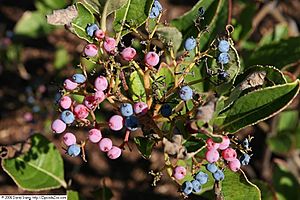Viburnum nudum facts for kids
Quick facts for kids Viburnum nudum |
|
|---|---|
 |
|
| Conservation status | |
| Scientific classification | |
| Genus: |
Viburnum
|
| Species: |
nudum
|
Viburnum nudum is a type of deciduous shrub. This means it's a woody plant that loses its leaves every year, usually in the fall. It belongs to a plant group called Viburnum, which is part of the Adoxaceae family. This family also includes plants like muskroot.
You might hear Viburnum nudum called by other names. Some common names for this plant are withe-rod, witherod viburnum, possumhaw, and wild raisin. There's also a special type of this plant known as Viburnum nudum var. cassinoides.
Contents
What Does Witherod Viburnum Look Like?
The witherod viburnum is a shrub with thin stems. Its leaves grow in pairs, one on each side of the stem. In late spring, you'll see beautiful white flowers bloom on the plant.
Where Does Witherod Viburnum Grow?
This plant is native to North America. You can find it growing from southern Ontario and Quebec in Canada, all the way to Newfoundland. In the United States, it grows south to Florida and west to Wisconsin.
How Does Witherod Viburnum Help Nature?
The fruit of the witherod viburnum is a tasty snack for many wild animals. Deer also like to eat its leaves. This plant is also important for some insects. It's a host plant for the young (larvae) of spring azures and hummingbird clearwing moths. These insects need the plant to grow and develop.
Is Witherod Viburnum Protected?
In some parts of the United States, Viburnum nudum needs special protection. It is listed as endangered in Kentucky and Pennsylvania. This means there are very few of these plants left in those states. In Connecticut, it's considered a "special concern species" and is thought to be gone from the wild there.
How Native Americans Used Witherod Viburnum
Native American tribes have used the witherod viburnum for a long time.
Food Uses
The Abenaki people used the fruit of this plant for food. The Algonquin people also ate the berries from the cassinoides variety.
Traditional Health Uses
The Cherokee people used Viburnum nudum var. cassinoides for different health purposes. They would make a special drink from it to help with muscle cramps. They also used parts of the plant as a tonic and for fevers. Sometimes, they would use a liquid made from the bark to wash a sore tongue.
Images for kids





